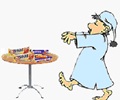Children who have at least one sibling who has been diagnosed with obstructive sleep apnea (OSA) may be at an increased risk of developing the sleep disorder, according to a study.
A new study has opined that children who have at least one sibling who has been diagnosed with obstructive sleep apnea (OSA) face a raised risk of developing the sleep disorder.
Published in the journal SLEEP, the study of the entire paediatric population of Sweden indicates that after accounting for socio-economic status, age, and geographic region, the sibling risk of paediatric OSA was extremely high, with a standardized incidence ratio of 33.2 in boys and 40.5 in girls who had at least one sibling with an OSA diagnosis.The study report says that a total of 854 boys and 627 girls who were 18 years of age or younger had a first hospital diagnosis of paediatric OSA during the study period; there was no significant gender difference in the incidence rate of OSA among those with a sibling history of the sleep disorder.
Lead researcher Dr. Danielle Friberg, a senior surgeon in the ENT department at Karolinska Institute in Stockholm, said that early intervention could help prevent the potentially severe consequences of OSA in children.
"Early diagnosis and treatment is important to avoid complications such as learning difficulties, 'failure to thrive,' serious cardiovascular complications and even death," said Friberg.
The researchers also studied the sibling risk of adenotonsillar hypertrophy, an important risk factor for pediatric OSA.
A total of 13,656 boys and 11,648 girls had a first hospital diagnosis of hypertrophy of the tonsils, or hypertrophy of the adenoids and tonsils.
Advertisement
The authors agree that this familial risk was much lower than in the group with OSA, but they say that the increase was highly significant and the numbers of children were much larger than in the OSA group.
Advertisement
Source-ANI
TAN















